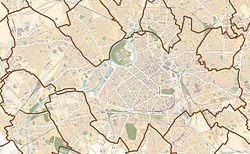| Lille Synagogue | |
|---|---|
French: Synagogue de Lille | |
 The synagogue in | |
| Religion | |
| Affiliation | Judaism |
| Rite | Nusach Ashkenaz |
| Ecclesiastical or organisational status | Synagogue |
| Status | Active |
| Location | |
| Location | 5, rue Auguste Angellie, Lille, Hauts-de-France |
| Country | France |
| Geographic coordinates | 50°37′42″N3°03′55″E / 50.6284°N 3.0654°E |
| Architecture | |
| Architect(s) | Théophile-Albert Hannotin |
| Type | Synagogue architecture |
| Style | |
| Date established | c. 1871(as a congregation) |
| Completed | 1891 |
| Materials | Stone |
| Official name | Synagogue |
| Type | Base Mérimée |
| Designated | 13 September 1984 |
| Reference no. | PA00107727 |
| [1] [2] | |
Lille Synagogue (French : Synagogue de Lille) is a Jewish congregation and synagogue, located at 5, rue Auguste Angellie, in Lille, in the Hauts-de-France region of France. [3] The congregation worships in the Ashkenazi rite.
